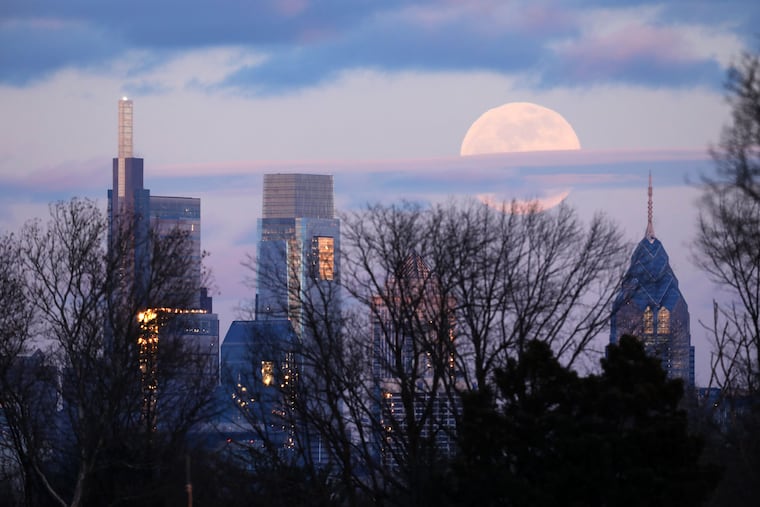Super, ‘Pink,’ or ‘Paschal,’ the moon makes its closest approach of the year
Wednesday night is looking like the best for viewing.

At precisely 2:08 p.m. Tuesday, the moon made its annual closest approach to the Earth. And when it became full at 10:35 p.m., it was knighted a “supermoon” — or “Paschal Moon” or “Pink Moon,” depending on whom is doing the knighting.
And Wednesday night should be another superb for moon watching, and if you can’t go outside, a window should do, and there’s always YouTube.
The moon still will be 98.3 percent full on Wednesday night, with the forecast calling for partly cloudy skies with a decent breeze from the northwest.
That means it will be playing peekaboo with those clouds, electrifying their edges as they pass, and casting its silvery light on the cherry, magnolia, and dogwood blossoms, which evidently have something to do with that “pink moon” business.
Just what is a ‘supermoon?’
Like the Earth’s orbit around the sun, the moon’s around the Earth is elliptical.
It can be as far away as 251,655 miles, and on Tuesday, it will be as close as it gets, says Derrick Pitts, the astronomer at the Franklin Institute. That’s roughly 221,773 miles away (acceptable social distancing plus about 221,772.99 miles).
Since it’s so close, it will appear about 12% larger than average when rising, said Frank Maloney, an associate professor of astronomy and astrophysics at Villanova University. But, he says, the notion that a supermoon appears brighter in the sky is myth.
Pitts said he believes the biggest distinction between a supermoon and others rests in the human imagination.
“People are willing to believe they can see the difference,” he said. “I don’t think that anybody can see that. None of us are immune to this.”
While it will appear larger as it rises above the horizon, Pitts notes that all full or nearly full moons look larger when they’re rising and setting — an optical illusion.
What’s with the names?
Throughout history, nature’s most powerful night light has had a profound relationship with human folklore.
The October full moon has been called everything from the Hunter’s Moon to the Dying Grass Moon to Sharad Purnima to a Blood Moon, according to NASA.
» READ MORE: The Hunter Moon will be a harvest for sky-watchers
This one, the first full moon of spring, often is known as the Paschal Moon, and it is associated with Passover, which begins Wednesday night, and Easter, which is celebrated on the first Sunday after the first full moon of spring.
The term Pink Moon has gained popularity recently, but it appears to have antiquarian roots, said Pitts. It is so named for all the pinkish blooms and blossoms out there. The moon itself will not be pink.
“There are different sets of these moon names that come from different cultures,” said Pitts.
But will the moon still be full Wednesday?
Technically, no, but it will be hard to tell the difference.
For that matter, it won’t be quite full at 10:36 p.m. Tuesday, notes Pitts.
The moon is ever restless in changing shape, waxing and waning, then reaching that 100% only for an instant. It still will be nearly full Wednesday night.
Pitts, incidentally, is not a huge fan of the full moon. He says that if you look at the full moon with a telescope or binoculars, the brightness of the direct light on the lunar surface is hard on the retina.
He’d prefer to look at it in its quarter phases, when the shadows would be more prominent and give the surface more definition.
“Things stick out at you. The edge of craters, the peaks of craters,” he said. “They give the moon dimensionality.”
Why make a big deal over a supermoon?
These days, no one should be looking a gift diversion in the mouth.
Said Pitts, “This is a really cool way to get people to get outside and look at the sky.”